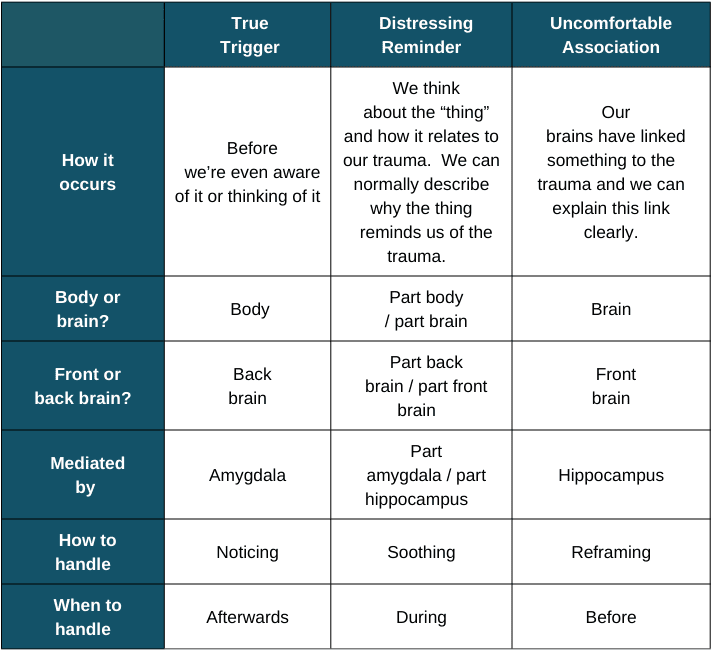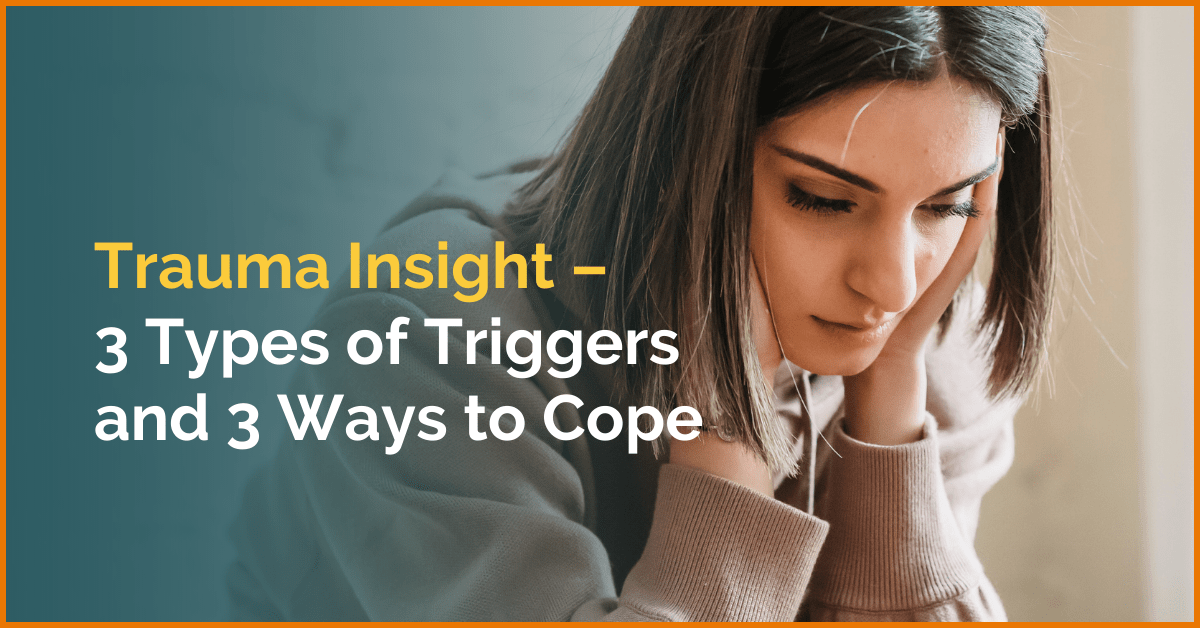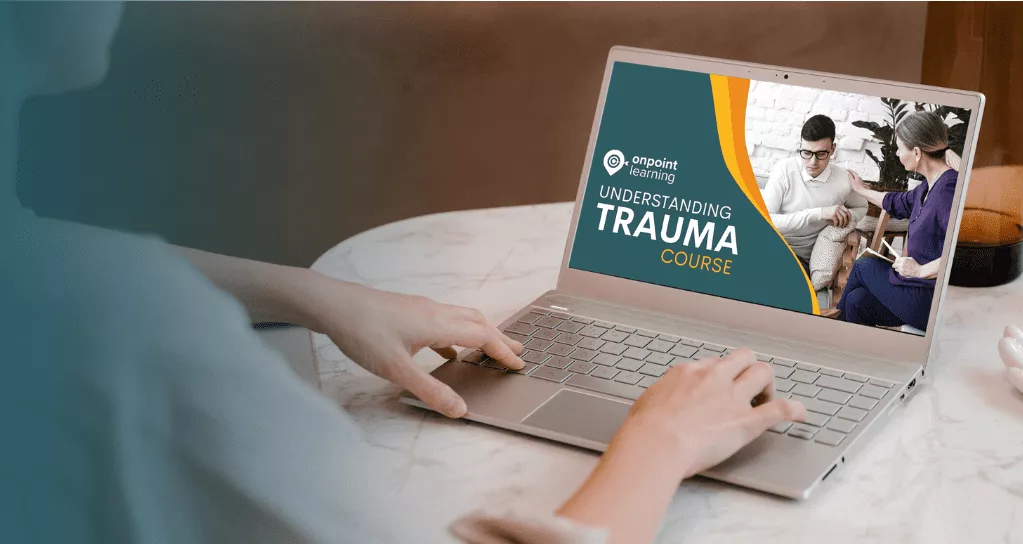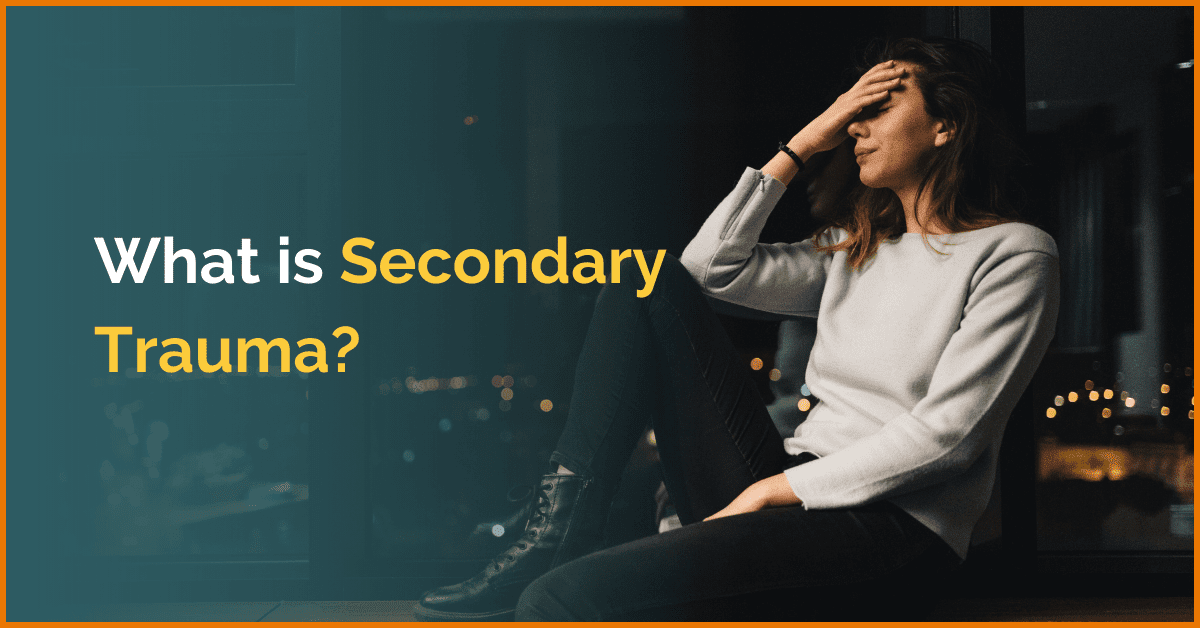3 Types of Triggers and 3 Ways To Cope
All I did was walk into the bathroom at the restaurant and look into the mirror to check my hair. Then I noticed the smell of disinfectant, a remnant from the cleaner making everything nice for the customers. I was immediately transported back in time, to a memory I had been trying to forget. I had been triggered. The traumatized version of myself was taking over, again. It wasn’t the first time and sadly, it wasn’t the last either.
My body responded the rising panic and fear, preparing my instinctive flight or fight response. My muscles went stiff, as if ready to spring into action. My chest pounded as I felt my heart rate increasing by the second.




“It’s just a smell”, I said to myself. “Its…just….a…smell”.
I grabbed the sink, just to feel something. The cold, hard, smooth service. Yes, focus on the cold. Focus on stopping the terror starting to take hold and overwhelm me.
These episodes have been happening for over 18 months now.
I ask myself the same questions:
- How can I lead a normal life?
- How do I work?
- Socialise with my remaining friends?
- Or even do the most mundane things like shopping for groceries?
It’s overwhelming. It’s exhausting, constantly wondering when the next event will happen. What will cause it? Where will I be? I’m exhausted just thinking about it and the constant debate in my mind before I do anything. Should I do it? Will I be triggered? Is it worth leaving the house?
Having finally regained a “normal” life, whatever that is, I feel so strongly that solutions are needed to help stop trauma survivors suffering from their triggers.
Avoidance is not enough. Empathy of those around is not enough. We don’t want sympathy. We want solutions. It’s more than that. We need solutions.




MY SHAME
It wasn’t my fault. I didn’t choose what happened to me. And so I was angry. So very angry.
I didn’t deserve this and I surely didn’t deserve the flashbacks and triggers
that I was left with, after the abuse had finally finished.
Why was I still letting the abuse affect me? I felt ashamed after each trigger.
I didn’t want to be like this and I hated that people, whether total strangers or my closest
friends, would see me react like this.
It wasn’t fair and after many months of focusing on how life was unfair and
obsessing about the unfairness everywhere I looked in the world, I finally realized – I had to deal with it.
It was up to me, to deal with the triggers. Nobody else could. Nobody else would.
Triggers are a reminder that you’re powerless. You couldn’t stop the abuse when it was happening.
You were powerless then. And you’re still powerless now as the triggers control your life.
A Life of Avoidance
It wasn’t my fault. I didn’t choose what happened to me. And so I was angry. So very angry.
I didn’t deserve this and I surely didn’t deserve the flashbacks and triggers
that I was left with, after the abuse had finally finished.
Why was I still letting the abuse affect me? I felt ashamed after each trigger.
I didn’t want to be like this and I hated that people, whether total strangers or my closest
friends, would see me react like this.
It wasn’t fair and after many months of focusing on how life was unfair and
obsessing about the unfairness everywhere I looked in the world, I finally realized – I had to deal with it.
It was up to me, to deal with the triggers. Nobody else could. Nobody else would.
Triggers are a reminder that you’re powerless. You couldn’t stop the abuse when it was happening.
You were powerless then. And you’re still powerless now as the triggers control your life.




cONTROLLING TRIGGERS
When the triggers come for you, they feel uncontrollable. Even looking at the articles, websites and posts online, many people consider a trigger to be something that is inevitable and unavoidable. That’s why there are “trigger warnings” in so many places now. Those little asterisks that serve as a reminder that people like me, the powerless, should be careful.
But triggers can be managed, controlled and we can choose NOT to be triggered. It’s not easy, but it can be done.
And once the triggers no longer controlled me, so that I could stay in my “green” zone in my “window of tolerance”, my life was transformed. It was a life worth living.
Trauma Insights
Fear is an important human emotion. It has kept us safe since the dawn of time.
And to keep us safe, fear starts before an event. What are you afraid of? Is it heights? Flying? Spiders? That big furry thing with long teeth and big mane of yellow fur?
Whatever your fear, the response is similar for all of us. For me, it starts in my stomach. I feel queasy and I stay motionless, as the fear starts to consume my body. My muscles start to shake as the adrenaline and other chemicals are dumped into my system. I can feel my chest starting to pound, as it becomes tight and I have trouble taking my normal deep breaths.
Every part of me is screaming danger.
Move. Go. Run.
And that human emotion, fear, is doing what it’s intended. It’s making me stop and react. To keep my safe.
My body responds physically, so that emotionally I respond. In this case, my emotional response Is fear.
Our minds and body remember these reactions. We use clues from the past events as a way to predict and get us ready for future events. Was it a crowded location last time it happened? Was it raining? Could I smell the disinfectant last time? Was the long jacket a warning signal I missed?
The brain doesn’t check whether or not it’s correct. There isn’t a careful, thoughtful, well-considered debate. It reacts. If it senses a similarity to the previous traumatic event, it reacts. The threat is coming!
React first, think later. That’s a trigger taking place. The trigger sets off the mental alarm that causes a strong physical and emotional reaction.
Three Types of Triggers




1. True Triggers
A true trigger happens when something in our environment – that we can physically see and touch – sets off our alarm.
It’s not a picture of a park bench – it’s an actual park bench you find yourself sitting on, feeling the hard wooden surface and feeling the grass under your feet.
The reminder activates your amygdala – the so called “back” portion of your brain. It’s nearly instant and any logical thinking or reasoning goes offline.
The window to deal with a true trigger is extremely small – just parts of a second – and so often dealing with true triggers happens afterwards. Changing the mindset from being ashamed of being triggered to using it as an opportunity for healing is a difficult transition to make.
To manage true triggers, we need to notice. More on that later.




2. Distressing Reminders
Reminders are just that. Memories or associations of what happened. They bring a range of emotions, often sadness, regret and other negative emotions.
Unlike true triggers, when distressing reminders happen, the front brain is still active and online. Which gives us a chance to work on soothing techniques, which specifically target the front brain, so we can deal with the reminders as they occur and limit their effect.




3. Uncomfortable Associations
When we build links between things and our trauma, we’re creating uncomfortable associations. The good news is these can normally be described and explained – “ I don’t like park benches because they remind me of being assaulted…”.
The solution to uncomfortable associations lies with reframing.
The Importance of Categories
Once we break down the generic term “trigger” into the thee different types, it becomes easier to understand what we’re dealing with. It’s less overwhelming and confusing. And now there’s a meaning for each trigger and a plan of how to manage them.
In summary:




Three ways to cope
1. Managing Uncomfortable Associations - Reframing
The abuse may have taken place in a forest and so we associate trees with that abuse. As we sit in waiting rooms, company offices or even our counsellor’s room, there’s a sense of disgust when we notice a picture of trees hanging on the wall.




It’s a reminder and our stomach feels tight, our muscles tense and the nauseous feeling returns. Our natural response is to remove that picture from the workplace. Or ask our counsellor to take it down. Life would be much easier if we didn’t have to deal with it.
Except, pictures of trees are everywhere. We can’t remove them all. Forever.
It’s not the picture that’s the problem, it’s our thoughts. We think of trees as negative because of their association, whereas most people would think of them positively.
We need to reframe things. To unpick our current association and replace them with new ones.
“Oh, I see what I’m doing. I’m linking this picture of a tree to my abuse. But that’s not helpful and it’s not actually keeping me safe. It’s my brain reacting to the past, not the future”.
The truth is that the tree isn’t dangerous. It was the abuser who was dangerous. So I need to break that link.
As I look at that picture, I’m going to think of trees differently. Now I think to myself, that I’m in a public park surrounded by nice people enjoying a sunny day. I’m under that tree, watching students play soccer; parents watch their young children exploring; couples having a picnic. I look up and see the bright purple flowers hanging from the leaves and falling all around me on the ground.
I say to myself “I feel safe. I am safe. It’s a happy place to be now”.
Each time I see a tree – I will repeat this view and this new association. Each time it will get easier and the old association will gradually fade.
If we want to be free from trauma, we must take control of the thoughts in our heads. We might not be able to stop the initial thought, but we can choose to flip them – to reframe them – from something negative to something positive.
As I used the reframing technique, I had to remind myself. “No! I will not let trauma ruin more things in my life. I will not keep repeating the negative association. Instead, I will persevere with repeating the positive and stop myself mid-negative thought.”




2. Managing Distressing Reminders - Soothing
More powerful than associations, but less powerful than triggers, are distressing reminders. They sit in the middle of our three trigger types.
As well as the mental reaction of our thoughts, there is also an emotional reaction as well. It’s not a full somatic response as we experience in a full triggering event, but the emotional reaction is still there, making its presence clear.
The good news is that our frontal brains are still working, which means we can make a conscious choice of what happens next. We must choose “soothing”.
When we let our body and brain know that we are safe, that nothing bad is going to happen now, we are soothing ourselves.
Breathing is key to soothing.
Breathing is also a great example of conscious and unconscious thought. How something can go move from our unconscious to our conscious by us choosing.
Right now, you’re breathing. And you’re not even thinking about it. Well, maybe now you are, but you weren’t 20 seconds ago.
When we breathe in, our sympathetic nervous system is activated. In moments of shock, we breathe in sharply, moving our body to amber alert as our heartrate increases in preparation.
Breathing out, however, activates our parasympathetic nervous system. It’s the green zone.
To override our bodies initial reaction as it begins jumping into action, consciously slowing our breathing is a key step. Slowing our breathing, taking a slower breath in (to a count of 5) and then a slow breath out (to a count of 5 or slightly longer), puts the break on our response.
For the full effect, mindful breathing for an entire minute, is better than a few slow breathes.
It’s not always easy to relax in the moment. Our amygdala is telling us there’s danger and to be alert – so relaxing in the moment takes effort. We need to take control through conscious thought.
Telling ourselves this is a reminder – not an actual traumatic event – and that we want to relax can prompt us to begin mindful breathing “I’ve got this, I’m not worried, I’m going to relax now because I know I’m safe in this moment despite being reminded of the past”.




3. Managing True Triggers - Notice
A true trigger is a full-blown emergency. It’s an event that is incredibly difficult to deal with – at first!
Sadly, few people can immediately come up with a solution that works straight away. But the good news is that you can definitely make progress and get through this with time. But let’s start at the beginning.
When the triggers first start happening, it’s common to feel angry afterwards. Angry that it happened to you and ashamed that you “let it” happen. You may even turn on yourself, telling yourself off for being helpless, letting the abuse still control you, for letting it happen in the first place or a wide range of negative self-talk.
So even though you may not be able to stop the initial trigger, you can stop the judgement afterwards. Be kind to yourself. Triggers are common and you’re human. If your friend was berating themselves about this, you’d show them compassion and understanding.
By showing yourself compassion and understanding about being triggered, and not beating yourself up about it, you start to reduce your body’s reaction. You are learning that a trigger is something that happens – it’s not real danger. You were triggered, it passed and then you went back to normal. Nothing bad happened and you are still safe.
Triggers are all about emergencies. It feels like an emergency. If feels like something is happening right now. It feels like we’re about to die.
Using the word “just” is a good step. It’s helps us realise the situation isn’t a true emergency – it’s something that happened, passed and now we carry on. By saying we were “just” triggered by “just” a tree, we learn there isn’t any danger and that we’re safe.
Because if we don’t feel safe, we’ll keep being triggered. One of the keys to recovery from triggers and flashbacks is to work towards feeling safe.
And this means that, realistically, you’ll have to start telling yourself you’re safe even before you really feel it.
So, the first step is to “just notice” the trigger has happened. Reassure yourself that you’re safe now
Next, be compassionate to yourself and be gentle. Minimise the damage caused by the trigger. If you bumped your elbow by accident, you wouldn’t then hit yourself on the head as punishment for bumping your elbow. So why punish yourself for a trigger which is an entirely natural, human reaction to trauma?
Building reassuring mantras and phrases is the next step. These should be built into our daily lives, making them a conscious thought so that in time, our unconscious mind can start doing things out of habit.
We can’t tell you the best mantra to use – it’s personal and unique to you. But they should be short and simple, so you can repeat them easily and frequently. You might want to write them down, as a physical and reassuring reminder to practice them throughout the day.
SUMMARY
It can be overwhelming trying to deal with triggers. By understanding 3 common types, it becomes easier to identify not only which are affecting you, but also put in place strategies and techniques to overcome them.
- If it’s an uncomfortable association – reframe it.
- If it’s a distressing reminder – soothe your body and mind.
- If it’s a true trigger, just notice, be compassionate and remind yourself that you’re safe.
Unfortunately, it’s not easy. Recovery from trauma takes work and time. It’s like most things in life – you didn’t learn a backflip, a language, to paint or those funky dance moves, the very first time you tried. It took practice, repetition and a desire to change.
The rewards are tremendous and so putting the effort to retraining your brain will be worth the effort. Trust the process, seek out the help and support you need. You’ll get there.







